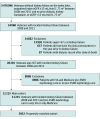Dialysis Initiation and Mortality Among Older Veterans With Kidney Failure Treated in Medicare vs the Department of Veterans Affairs
- PMID: 29630695
- PMCID: PMC6583073
- DOI: 10.1001/jamainternmed.2018.0411
Dialysis Initiation and Mortality Among Older Veterans With Kidney Failure Treated in Medicare vs the Department of Veterans Affairs
Erratum in
-
Numeric Errors in Table 1.JAMA Intern Med. 2018 Nov 1;178(11):1568. doi: 10.1001/jamainternmed.2018.6396. JAMA Intern Med. 2018. PMID: 31381668 Free PMC article. No abstract available.
Abstract
Importance: The benefits of maintenance dialysis for older adults with end-stage renal disease (ESRD) are uncertain. Whether the setting of pre-ESRD nephrology care influences initiation of dialysis and mortality is not known.
Objective: To compare initiation of dialysis and mortality among older veterans with incident kidney failure who received pre-ESRD nephrology care in fee-for-service Medicare vs the Department of Veterans Affairs (VA).
Design, setting, and participants: Retrospective cohort study of patients from the US Medicare and VA health care systems evaluated 11 215 veterans aged 67 years or older with incident kidney failure between January 1, 2008, and December 31, 2011. Data analysis was performed March 15, 2016, through September 20, 2017.
Exposures: Pre-ESRD nephrology care in Medicare vs VA health care systems.
Main outcome and measures: Dialysis treatment and death within 2 years.
Results: Of the 11 215 patients included in the study, 11 085 (98.8%) were men; mean (SD) age was 79.1 (6.9) years. Within 2 years of incident kidney failure, 7071 (63.0%) of the patients started dialysis and 5280 (47.1%) died. Patients who received pre-ESRD nephrology care in Medicare were more likely to undergo dialysis compared with patients who received pre-ESRD nephrology care in VA (82% vs 53%; adjusted risk difference, 28 percentage points; 95% CI, 26-30 percentage points). Differences in dialysis initiation between Medicare and VA were more pronounced among patients aged 80 years or older and patients with dementia or metastatic cancer, and less pronounced among patients with paralysis (P < .05 for interaction). Two-year mortality was higher for patients who received pre-ESRD care in Medicare compared with VA (53% vs 44%; adjusted risk difference, 5 percentage points; 95% CI, 3-7 percentage points). The findings were similar in a propensity-matched analysis.
Conclusions and relevance: Veterans who receive pre-ESRD nephrology care in Medicare receive dialysis more often yet are also more likely to die within 2 years compared with those in VA. The VA's integrated health care system and financing appear to favor lower-intensity treatment for kidney failure in older patients without a concomitant increase in mortality.
Conflict of interest statement
Figures



Comment in
-
Appropriate Time for Chronic Dialysis Initiation: A Cause for Humility.JAMA Intern Med. 2018 May 1;178(5):664-666. doi: 10.1001/jamainternmed.2018.0470. JAMA Intern Med. 2018. PMID: 29630690 No abstract available.
-
Dialysis in Older Adults: Is Later Start the Preferred Approach?Am J Kidney Dis. 2019 Feb;73(2):285-287. doi: 10.1053/j.ajkd.2018.09.001. Epub 2018 Oct 25. Am J Kidney Dis. 2019. PMID: 30482580 No abstract available.
References
-
- Williams AW, Dwyer AC, Eddy AA, et al. ; American Society of Nephrology Quality, and Patient Safety Task Force . Critical and honest conversations: the evidence behind the “Choosing Wisely” campaign recommendations by the American Society of Nephrology. Clin J Am Soc Nephrol. 2012;7(10):1664-1672. - PubMed
-
- Moss AH. Revised dialysis clinical practice guideline promotes more informed decision-making. Clin J Am Soc Nephrol. 2010;5(12):2380-2383. - PubMed
Publication types
MeSH terms
Grants and funding
LinkOut - more resources
Full Text Sources
Other Literature Sources
Medical

